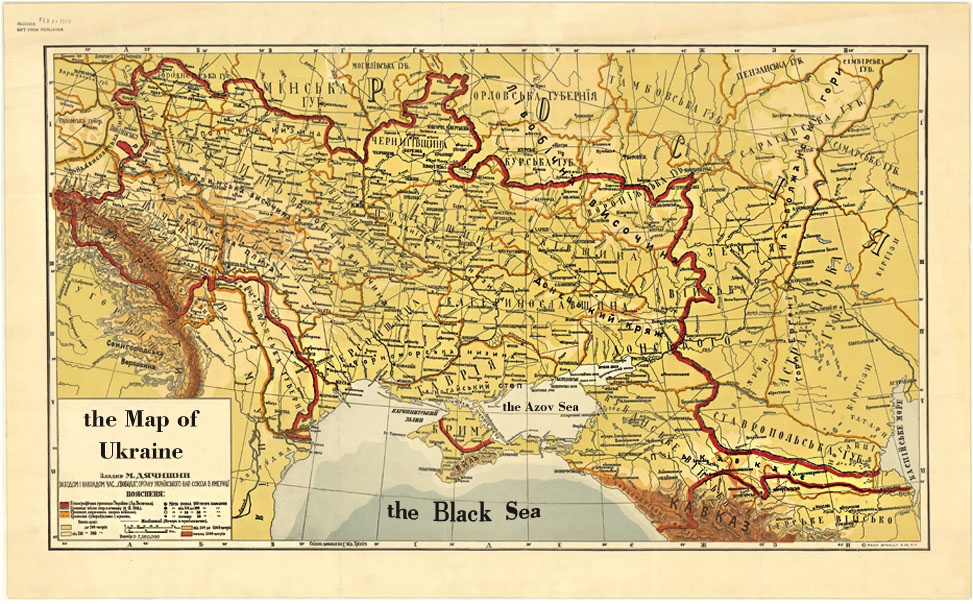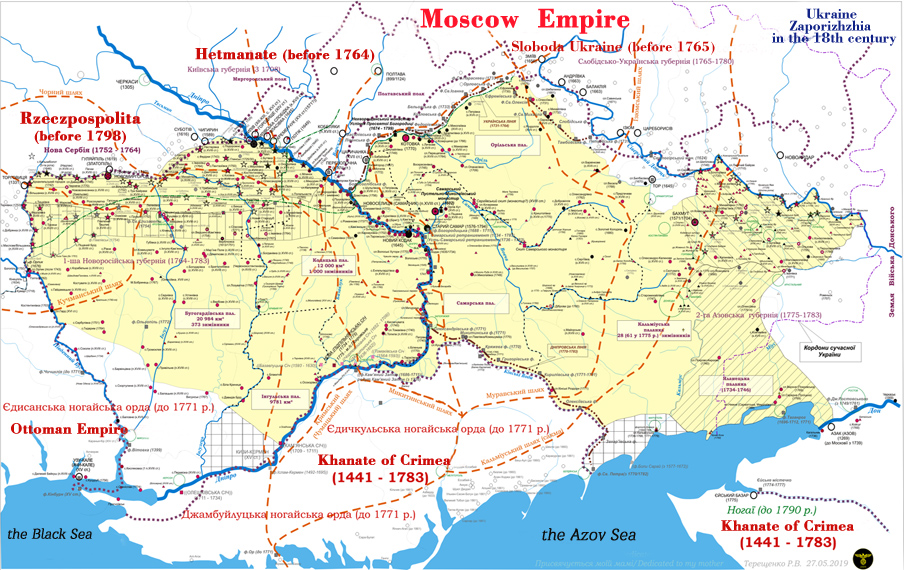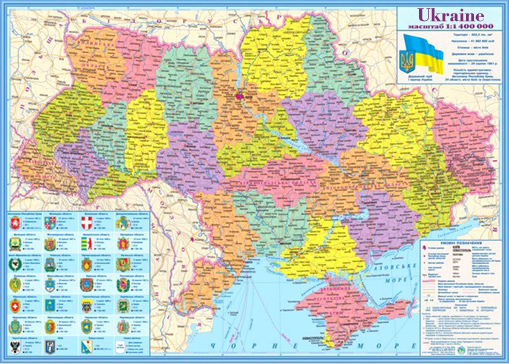Stereotypes 1-3. Creation of Ukraine, Historical Lands and “One Nation”
Contemporary Map of Ukraine// https://www.chaspik.ua/karta-48199/#galery
One of the most significant directions in the contemporary Russian-Ukrainian war is information. Information, both in the past and currently, is a tool capable of acting as effectively as the weapons. The difference is in targeting: accordingly represented information is able to destroy the identity. And this, in its turn, is able to capture any country without a single shot.
Long before the open military aggression of Russia against Ukraine, Putin V. published his article “On the Historical Unity of Russians and Ukrainians” (2021). In fact, Putin's article is the collection of the trivial issues based on the imperial and the Soviet theses of anti-Ukrainian propaganda and is pointless from the history point of view.
The principal ideas of Putin's article can be summarised as follows:
• Ukraine is the country established by the Soviet politics;
• The Russians and the Ukrainians are the one nation;
• The territory under the control of Ukraine is the historical land of Russia.
Stereotype 1. Ukraine is the Country Established by the Soviet Politics
It is said that the borders of Ukraine and the Ukrainian state itself were established by the activity of Soviet Union Bolshevik government (with V. Lenin in charge) and are the results of adding the South-Eastern lands, the western land and the Crimea to Ukraine.
If to regard formally the aspect of the Ukrainian state foundation during the Soviet period, the same thesis is applicable towards the contemporary Russia, which administrative division and borders were outlined exactly at the period of Communist Bolshevik government.
Before the Bolshevik coming into power, the borders of Russia were different and it was ruled by the tsar but not by the gensek (general secretary).
From the very beginning, the discussed thesis was a pure manipulation, since the state in its development passes the different stages.
Actually, everything is absolutely different from what is claimed by the Russian. When the Russian ethnos only started to form (in the 11th-12th centuries), the Medieval Ukrainian state of Rus/ Kievan Rus had already formulated its the principal ideologeme of preserving the leading position of Kyiv over the other Rus (Ukrainian) lands as well as over the jointed ones. The idea of unity for the Ukrainian lands was burning at the times of Halytsian-Volynian (Galicia-Volhynia) principality, and even at the times when the Ukrainian lands were under control of the Kingdom of Poland and were the part of Magnus Ducatus Lithvaniae et Russiae. In 1657, Bohdan Khmelnytsky said to the Swedish ambassador that “the Cossacks are in the pursuit of the Old Ukraine or Rus, where the Greek (Orthodox) faith was worshipped and the language spreading to the Vistula River”. In the 19th century, the programmes of the Ukrainian parties expressed the desire for struggling for the state, independent and united. Famous booklet “Independent Ukraine” by M. Mikhnovskyi proclaims “Ukraine is single in its unity, indivisible, free, independent and spreading from the Carpathian Mountains and to the Caucasus”. During the Ukrainian National Revolution of 1917–1921, the idea of uniting affected not only the Ukrainian regions of Naddniprianshchyna, Halychyna (Galicia), Bukovyna and Zakarpattia, but also the Ukrainians of Kuban and of those parts of the Russian Governorates, which historically belonged to Slobidska Ukraine. During the 1920s-1940s, as the consequence of the numerous treaties, which the Soviet Union prepared and concluded without the participation of the Ukrainian representatives, the Ukrainian ethnic territories were incorporated into the Russian Republic, the Belarusian Republic, the Polish Republic and the Czechoslovak Republic.

Thus, according to the evidences of the historic documents, Ukraine as the state had been existing much earlier than the Soviet Union was founded. Moreover, the establishment of the borders of the Soviet Ukraine was performed without taking into account the opinion of the Ukrainians. Due to such policy, Ukraine was robbed of the own ethnic territories and in favour of Russia as well.
Stereotype 2. The Russians and the Ukrainians are One Nation
This is a rather old idea of the Soviet propaganda concerning the brotherhood of the Russians, the Ukrainians, and the Belarusians. The Russian narrative on the triune nation originated in the imperial Russian rule. Actually, there is no notion of the “brothering nation” in geopolitics. Every nation has its own targets and pursuits them, often at the account of other nations.
Historically, the Ukrainian nation started its establishment during the period of Rus/ Kievan Rus, in the 9th-11th centuries, while the starting point for the Russian ethnos is attributed to the 11th-12th centuries. During the period of the 12th -16th centuries, the Ukrainians and the Russians lived under different historical and cultural realities and had the different attitudes and values. After the Mongol invasion of the 13th century, Russia was under the strong Asian influence of Horde and under the rule of authoritarian government, while Ukraine continued its development in the European context direction with strong democratic traditions. Before incorporating the Ukrainian lands into the Russian state in the 18th century, the Ukrainian culture was self-sustaining and developing under the influence of Europe. The Ukrainian language grammatically and syntactically is closer to Polish and Belarusian than to Russian. Genetically, the Ukrainians possess the mighty Slavic grounds, while the Russians have the Finno-Ugric ones, and they are closer to the Estonians and the Finns.
Certainly, being more than 300 years under the Russian occupation and tolerating the artificial assimilation and unification, the Ukrainians borrowed some every-day practices having been known as belonging to the Russian culture. However, all of them are not natural for the Ukrainians and lost their importance in the contemporary world.
Eventually, the Ukrainians and the Russians differ significantly in their histories, cultures, psychological characteristics and even the everyday-life aspects.
Stereotype 3. The Ukrainian Lands are Historically the Russian lands
This thesis rose up during the period of the Russian Empire ruling on the Ukrainian lands. In April 2014, on annexing the Crimea and invading Donbass, V. Putin, the president of the Russian Federation, claimed: «It should be reminded, that it is Novorossiya. Kharkov, Lugansk, Donetsk, Kherson, Nikolaiev, Odessa were not within Ukraine during the times of the tsar reign». As back as in the 1830s and the 1840s, the ideological concept of the Russian Empire was elaborated to deny any contribution of the Zaporozhian Cossacks and other Ukrainian people into the economic development of the territories on the East and the South of Ukraine. These lands, they say, even though belonged to the Zaporozhian Host but were not settled. The true colonisation allegedly began here only due to the Russia at the last quarter of the 18th century, after elimination of the Zaporozhian Sich in 1775. The best proof for the artificial character of Novorossiya is the fact that even the Muscovite upper-class did not consider the lands of the Eastern and the Southern Ukraine to be the Russian territory until the end of the 18th century.
Actually, within the territory of the contemporary Ukraine, there are no historical lands of its bordering countries.

At this, a considerable part of the historical lands of Ukraine is within the other western countries: Kholmshchyna, Nadsiannia and Pidliashshia. At the territories of Kholmshchyna and Nadsiannia, the pra-Ukrainian tribes colonised the left-bank territories of the western Bug, coming to the Vepr River and to the Vistula River. At the territory of the contemporary Romania, there are old Ukrainian lands of the Pivdenna Bukovyna (the Southern Bucovina), the Pivdenna Marmaroshchyna (the Southern Maramureș), and Podunavia. The Northern Marmaroshchyna belongs to Zhakarpatska oblast of Ukraine. The Ukrainian settlers came here earlier than the Vlachs. Bukovyna and Podunavia of Bârlad Principality in the 12th - 13th centuries were the part of Halytsian-Volynian Principality, which is considered an heir of the Kievan Rus. The contemporary border between Ukraine and Belarus does not reflect the ethnic settlement of the Ukrainians and the Belarusians. The Ukrainian ethnic territories are assumed within Beresteishchyna, the South of Pinsk and Mozyrsk Polissia (Pinsk and Mozyr Marshes), Homelshchyna. The greatest part of those Ukrainian ethnic territories which are under the control of the other countries is in the Russian Federation. Thus, within the Russian Federation, one can distinguish a considerable part of Starodubsk Polk (regiment) of Hetmanshchyna (Hetmanate), this territory now is within the Bryansk Oblast of the Russian Federation. The said historic division was annihilated by the Russian Empire in 1764. Also, Ostroh (Ostrog) Polk of Slobidska Ukraine is currently within the Russian and is named as Voronezh Оblast. This territory was colonised by the Ukrainians at the second half of the 17th century as the result of the population movement to the East from the Livoberezhzha of the Dnipro River (The Left-Bank of the Dnieper). The same destiny had the Northern parts of four Slobozhanshchyna Polks: Kharkivskyi, Sumskyi, Okhtyrskyi, Iziumskyi (contemporary Kursk and Belgorodsk Оblasts of the Russian Federation). In the South-East and beyond the borders of the contemporary Ukraine, there have appeared the lands used to be colonised by Zaporozhian Cossacks and the Ukrainians: Kuban and the East Coast of the Azov Sea; it is Taganrog and its vicinity. In the 20th century, to the Russian Soviet Federated Socialist Republic was given the territory located in the area of the lower Siverskyi Donets (Siverskyy Donets), named as Shakhtynsk okrug.
Eventually, the contemporary Ukraine as a state exists on its own ethnic territories and reflects the principal features of the Ukrainian ethnos settlement from the middle of the 1st millennium.
The current publication is based on the research of the Ukrainian Institute of National Remembrance and quotes of the book by V. Brekhunenko (Брехуненко В. Війна за свідомість. Російські міфи про Україну та її минуле.‒ Київ, 2017.‒ 280 с.)
Ihor Kocherhin, the doctor of historical sciences, the head of the South-East Interregional Department of Providing Implementation of the National Remembrance Policy in the Regional Ukrainian Institute of National Remembrance, professor of Dnipro University of Technology, captain of the Ukrainian armed forces
Audio podcast Creation of Ukraine, Historical Lands and “One Nation”
Our Advice to Read:
Білінський В.Б. Україна-Русь: історичне дослідження: у 3-х кн. Кн. 1. Споконвічна земля.– Тернопіль: Навчальна книга-Богдан, 2018.– 384 с.: іл.
Гаврилів І. Україна – Росія: протиборство европейської та евразійської цивілізацій.– Львів: Левада, 2018.– 107 с.: 3 л. карт.
Народження країни. Від краю до держави. Назва, символіка, територія і кордони України.– Харків: Клуб сімейного дозвілля, 2017.– 352 с.: карти.– (Історія без цензури).
Семененко В.І. Хто такі українці? Що таке Україна?.– Харків: Школа, 2010.– 160 с.– (Історичний архів. Маленькі таємниці великої історії).
Сергійчук В. Етнічні межі і державний кордон України.– Вид. 3-є, допов.– Київ: Сергійчук М.І., 2008.– 560 с.
Смолій В.А., Гуржій О.І. Як і коли почала формуватися українська нація.– К.: Наук. думка, 1991.– 112 с











